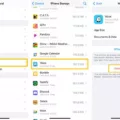The iPhone has become an essential part of our daily lives, serving as a hub for communication, entertainment, and productivity. However, one issue that many iPhone users face is the constant growth of Other/System Data on their devices. This mysterious data category seems to take up an excessive amount of storage space, leaving users perplexed and frustrated. In this article, we will delve into the root causes of this problem and explore potential solutions.
One of the biggest culprits for the ballooning Other/System Data is streaming music and video. When you download media from sources such as the iTunes Store, TV app, or Music app, it is neatly categorized as Media. However, when you stream content, caches are created to ensure smooth playback, and these caches are classified as Other/System Data. Over time, these caches can accumulate and take up a significant amount of storage space.
To tackle this issue, a simple solution is to disconnect your iPhone from the internet and proceed with a reset. This will not only clear the caches but also erase all content and settings on your device. To do this, open the Settings app, go to General, and select “Reset iPhone.” From there, choose the option to “Erase All Content and Settings.” Follow the prompts to complete the process.
It’s important to note that performing a reset will delete all your personal data, so ensure that you have backed up your iPhone beforehand. You can do this by connecting your device to your computer and using iTunes or by utilizing iCloud backup. This way, you can restore your data once the reset is complete.
Another approach to managing Other/System Data is to review and delete unnecessary files and apps. Sometimes, temporary files, app caches, and unused apps can accumulate and contribute to the storage problem. To identify and remove these files, go to Settings, then General, and select iPhone Storage. Here, you will find a detailed breakdown of your storage usage, including the amount of space occupied by Other/System Data. Tap on individual apps to see if there are any sizable caches that can be cleared or if there are any unused apps that can be deleted.
In addition to these solutions, keeping your iPhone up to date with the latest software version can also help optimize storage usage. Apple continuously releases updates that address bugs and improve system performance, which can indirectly impact the growth of Other/System Data.
While the exact causes and solutions for the Other/System Data issue may vary from user to user, these steps should provide a good starting point for managing and reducing this storage-hogging category. By taking proactive measures and regularly monitoring your storage usage, you can ensure that your iPhone remains efficient and clutter-free.
The growth of Other/System Data on iPhones can be a frustrating issue for many users. By understanding the underlying causes and implementing the suggested solutions, you can regain control over your device’s storage and optimize its performance. Remember to back up your data before attempting any reset and regularly review and delete unnecessary files and apps. By taking these steps, you can reclaim valuable storage space and enjoy a smoother iPhone experience.
Why is Your iPhone System Data So Large?
The size of the system data on your iPhone can be quite large due to various reasons. Here are some possible explanations for why your iPhone system data might be taking up a significant amount of space:
1. Cached Files: When you use various apps, they often store temporary files or caches to enhance performance. These files can accumulate over time and contribute to the system data size.
2. App Data: Some apps generate and store a significant amount of data, such as documents, offline maps, or databases. This data is categorized as system data and can consume a considerable portion of your device’s storage.
3. System Updates: When you update your iPhone’s operating system, the update files can temporarily be classified as system data until the installation process is complete. These files are necessary for the update process but may take up a substantial amount of space.
4. Mail Attachments: If you receive and download email attachments frequently, they may be stored within the system data. These attachments can accumulate over time and contribute to the overall size of the system data.
5. Safari Offline Reading List: If you use Safari’s offline reading list feature, web pages you save for offline reading are stored as part of the system data. If you frequently save web pages, this can increase the system data size.
6. Streaming Media: Streaming music and video services, such as Apple Music or Netflix, often use caches to ensure smooth playback. These cached files are categorized as system data, and if you frequently stream media, they can take up a significant amount of space.
7. Diagnostic Data: Your iPhone may collect diagnostic and usage information to improve its performance. This data is categorized as system data and can contribute to its overall size.
To manage and reduce the size of your iPhone’s system data, you can try the following:
– Clear app caches: Some apps allow you to clear their caches within their settings. Go to Settings > [App Name] > Clear Cache to free up space.
– Offload unused apps: Go to Settings > General > iPhone Storage and select “Offload Unused Apps.” This will remove unused app data but retain the app’s icon and documents in case you reinstall it later.
– Delete unnecessary offline files: If you have offline files saved in apps like Safari or other document management apps, consider deleting them if you no longer need them.
– Regularly update your iPhone’s software: Keeping your iPhone updated with the latest iOS version can help optimize storage by removing temporary update files and improving system efficiency.
– Delete unneeded mail attachments: Review your email attachments and delete any unnecessary ones to free up space.
Remember, it’s always a good idea to regularly back up your iPhone and its data before performing any storage management tasks.

How Do You Clear System Data On You iPhone?
To clear system data on your iPhone, follow these steps:
1. Disconnect your device: Make sure your iPhone is not connected to any other devices or accessories.
2. Open Settings: Locate and tap on the Settings app on your iPhone’s home screen.
3. Go to General: Scroll down and tap on the “General” option.
4. Reset iPhone: In the General settings, scroll to the bottom and tap on the “Reset” option.
5. Erase All Content and Settings: Among the reset options, select “Erase All Content and Settings.”
6. Confirm the action: A prompt will appear warning you that this action will delete all data on your iPhone. If you’re sure you want to proceed, tap on “Erase iPhone.”
7. Follow the prompts: Your iPhone will guide you through the process of erasing all content and settings. You may need to enter your passcode or Apple ID password for security purposes.
8. Wait for the reset: The erasing process may take a few minutes. Your iPhone will restart and display the setup screen once it’s completed.
By following these steps, you will be able to clear system data on your iPhone and restore it to its factory settings. Keep in mind that this will remove all your personal data, so make sure to back up any important information before proceeding.
Conclusion
The issue of iPhone system data growing excessively, particularly in the form of Other/System Data, is a common problem faced by many users. One of the major contributors to this problem is the streaming of music and video on the device. While downloaded media is categorized as Media, the caches created during streaming are classified as Other/System Data, thus leading to its significant accumulation over time.
To tackle this issue, one effective solution is to reset the iPhone by erasing all content and settings. This will not only remove unnecessary system data but also provide a fresh start for the device. To do this, disconnect the device and navigate to the Settings app. From there, go to General and select “Reset iPhone.” Choose the option to “Erase All Content and Settings” and follow the prompts to complete the process.
By taking these steps, users can effectively manage and reduce the size of their iPhone’s system data. It is important to note that regular maintenance and periodic resets can help prevent the accumulation of unnecessary data, ensuring optimal performance and storage management on the device.








